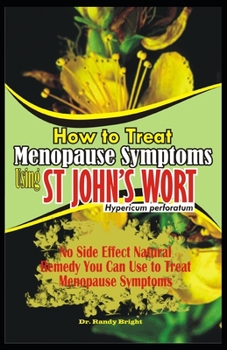How to Treat Menopause Symptoms using St John's Wort: No side Effect Natural Remedy you can use to Treat Menopause Symptoms
Erect perennial herb 30-90 cm high reproducing by seeds or from rhizomes at the base of the stem. Stems much branched, 2-sided or ridged with black glands along the ridges, hairless, a distinctly dark ring at the lower nodes. Leaves simple, opposite, pinnately netted, with no stalk, usually without teeth, hairless with translucent dots, apex rounded. Flowers showy, yellow, in fairly flat-topped clusters at the top of the plant. Sepals 5, green, lance-shaped, 5 mm long, 1 mm wide. Petals 5, yellow with black glandular dots along the margins, 14-15 mm long, 8 mm wide. Stamens many; one pistil with style 3-parted and widely divergent; fruit a capsule; seeds l.l x 0.5 x 0.5 mm, black, reticulate and with short, sharp points at the ends.Commonly called SJW, klamath weed, tipton weed, goat weed, and enola weed (Muenscher 1946), H. perforatum is a perennial flowering herb belonging to the Clusiaceae (Mangosteen family; alternatively, Hypericaceae and Guttiferae). The genus Hypericum consists of approximately 400 species of herbs and shrubs having yellow or coppery flowers with four to five petals, numerous stamens, and a single pistil (Gleason and Cronquist 1991).H. perforatum consist of freely branching shrubby herbs that typically range from 40 to 80 cm in height (Muenscher 1946; Gleason and Cronquist 1991). The stems and branches are densely covered by oblong, smooth-margined leaves that range from 1 to 3 cm long and 0.3-1.0 cm wide (Figure 11.1). The leaves are interrupted by minute translucent spots that are evident when held up to the light. The upper portions of mature plants can produce several dozen five-petaled yellow flowers that are typically 1.0-2.0 cm wide. The edges of the petals are usually covered with black dots. Crushed flowers produce a blood-red pigment. By late summer, the flowers produce capsules that contain dozens of tiny, dark-brown seeds. The species is a native of Europe, but has spread to temperate locations in Asia, Africa, Australia, and North and South America (Gleason and Cronquist 1991; Foster 2000). It thrives in poor soils, and is commonly found in meadows, fields, waste areas, roadsides, and abandoned mines and quarries (Muenscher 1946; Klemow and Raynal 1983; Gleason and Cronquist 1991). Due to concerns over phototoxicity to livestock, H. perforatum is listed as a noxious weed in seven western states in the United States. Programs promoting its eradication are underway in Canada, California, and Australia.
Format:Paperback
Language:English
ISBN:1710378689
ISBN13:9781710378689
Release Date:November 2019
Publisher:Independently Published
Length:28 Pages
Weight:0.10 lbs.
Dimensions:0.1" x 5.5" x 8.5"
Customer Reviews
0 rating





